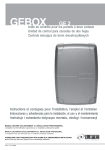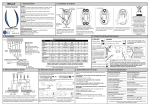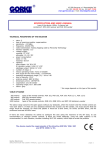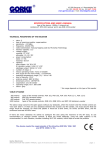Download 43-200 Pszczyna, ul. Staromiejska 31b tel. 032
Transcript
43-200 Pszczyna, ul. Staromiejska 31b tel. 032 326 30 70, fax 032 447 73 30 www.gorke.com.pl, e-mail: [email protected] SPECIFICATION AND USER’s MANUAL type of the device: 4-channel receiver type RSW-004 TECHNICAL PARAMETERS • • • • • • • • • • • • • • • • type of receiving module: superreaction or superheterodyne sensitivity: -100 with SR (-115 with SH) dBm frequency: 433,92 MHz radio transmission: KeeLoq hopping code by Microchip Technology memory capacity: 99 devices, including up to 20 sensors voltage supply: nominal: 12 V DC allowable: 10-15 V DC power consumption: static: 40 mA maximal: 100 with SR (120 with SH) mA capacity: relay output: 1A/ 30 V DC S signal output: 500mA sabotage output: 1A/ 30 V DC number of relays: 6 (including 4 channel, 1 low battery level, 1 sabotage) relay's operating mode: mono or bistable time scope for the mono mode: ~0,2s-109min operating temperature range: 0 to +40°C antenna: outlet to clamp terminal dimensions (mm): 99*62*29 cooperation: any GE sender and sensor operating range (m)*: superreactive SR module: 100-500 syperheterodyne SH module: 200-1000 * the range depends on the type of the sender The above range concerns the open space (without any obstacles, when the receiver and the remote control can “see each other”). If there are any obstacles between the receiver and the sender, one must assume that the range would be reduced: for wood and plaster it would be 5-20% lower, for bricks 20-40% lower, and for reinforced concrete 40-80% lower. __________________ GENERAL CHARACTERISTICS OF THE DEVICE _______________ • • • • • • • • • • • it can cooperate with the main wire alarm control panel it can operate as an independent control panel universal 4-channel controller – one can control any device, for example, a gate, a barrier or lighting it cooperates with wireless GORKE Electronic sensors (CRB) and any remote controls by GORKE Electonic (PUK, RNB, NRP) – up to 99 devices S output (signals arm/disarm state); type: open collector (capacity: 500mA) 4 independent relay outputs for free use (capacity: 1A) SAB/AL relay output – it signals sensors’ sabotage. In the independent operating mode it is used to control the external signaller BAT relay output – it signals sensors’ low battery level UZB input – it arms the control panel with the external input – from the main control panel or external encryptor each channel may operate with five sensors or remote control buttons (the number is limited by the total number of devices – up to 99) memory of the arm state in case of lack of power supply Gorke Electronic SPECIFICATION AND USER’s MANUAL: 4-channel receiver type RSW-004 page: 1 GND ANT K1 JP1-4 JP7 JP6 JP5 JP6 JP5 NC WE K1 K2 K2 K3 K3 K4 K4 BAT BAT S UZB SAB/AL+12 GND NO PILOT JP1 JP2 JP3 JP4 JP7 CENTR STER UZB K1 SAB K2 BRAK TESTU K3 BAT K4 ROZBR. WYJŚCIE PRG WYBÓR fig.1. – view of RSW-004 ___________________ CHARACTERISTICS OF DEVICE’S OPERATING _________________ 1. CONTOL PANEL mode - in this mode the RSW-004 controller with GORKE Electronic sensors (CRB), GORKE Electronic remote controls (PUK, RNB, NRP) together with appropriately connected signaller enables the protection of small objects. The control panel may be armed from an external encryptor or from a remote control button ascribed to the channel 4. 2. Connection example scheme - sensors on the channels 1 and 2 - arming from the button of the first remote control (or from an external encryptor, depending on the setting of the J6 switch - the arming is signalled while arming from the remote control – the diode is connected to the output of the channel 4 (channel 4 in the bistable mode) - work with external signaller szyfrator sygnalizator Buzzer 12V + GND ANT K1 K1 K2 K2 K3 K3 K4 K4 BAT BAT S Gorke Electronic SPECIFICATION AND USER’s MANUAL: 4-channel receiver type RSW-004 UZB +12V GND SAB/AL + 12 GND page: 2 szyfrator Buzzer 12V + Nadajnik lub dialer SAB/ALARM BATERIA UZB./ROZBR. NAPAD K2/ALARM K1/ALARM K2 K2 K3 K3 K4 K4 zbr. r./ro uzb K1 d pa na GND ANT K1 +12V GND BAT BAT S UZB SAB/AL + 12 GND 3. Configuring the operating mode - in order to set the CONTROL PANEL mode, you need to set the J5 switch in the 1-2 position. 1 2 3 J5 4. Choosing the arming method - The control panel may be armed and disarmed in two ways, depending on the setting of the JP-6 switch: • with the arming input (by shorting to ground), for example from an external encryptor. Set the J6 switch in the 1-2 position: 1 • 2 3 J6 with the the button of the remote control assigned to the channel 4. Set the J6 swtich in the 2-3 position 1 2 3 J6 5. Control panel’s operating states The control panel operates in two states: armed or disarmed. The present state and all the events are signalled by lighting the appropriate LED diodes. - the green ARMED diode is lighted – the control panel is armed - the blue DISARMED diode is blinking – the control panel is disarmed 6. Signalling the change of arm state of the control panel - arm – this state is signalled by a single impulse on the S output and optionally in the CONTROL PANEL mode the ALARM relay will be open for 300ms - disarm – this state is signalled by two impulses on the S output and optionally in the CONTROL PANEL mode the ALARM relay will be open twice for 300ms 7. Receiving signals from the sensors The channel to which the sensors are ascribed operates in the monostable mode (it gets activated for a predefined period). If an alarm is received from a sensor: and the control panel is armed – the red diode corresponding to the channel will light and the relay in the channel will open and control panel is disarmed – the red diode corresponding to the channel will blink and the relay will not be open Gorke Electronic SPECIFICATION AND USER’s MANUAL: 4-channel receiver type RSW-004 page: 3 Opening the case of the sensor will cause a sabotage alarm, independently of the arm state of the control panel. It will be signalled by: lighting the SABOTAGE diode an impulse on the output of the channel to which the sensor was ascribed an impulse on the ALARM relay output (one minute interval between the impulses); if the control panel is armed – up to five times on the arming Independently of the arm state, the control panel receives signals from the sensors: NO TEST – it generates an impulse on the ALARM relay output or on the S output and it is signalled by lighting the NO TEST diode LOW BATTERY LEVEL – it opens the BAT relay output and lights the BATTERY diode 8. Receiving signals from remote controls A channel to which a remote control was ascribed may operate in two modes: - a monostable mode (it is activated for a pre-defined period) - a bistable mode (each stimulation changes the state of the channel output on the other one) In both cases the channel gets activated, independently of the arm state of the control panel. The blinking red diode which corresponds with the channel signals the activity. 9. CONTROLLER mode In this mode the RSW-004 controller together with GORKE Electonic sensors (CRB) may extend the existing wire alarm system, if the control panel is appropriately connected. Together with the GORKE Electronic remote controls (PUK, RNB, NRP) it allows for arming and disarming the existing wire alarm system using the remote control. The RSW-004 controller which operates in this mode may be used as a universal controller of, for example, lighting and gates, activated either by remote controls or sensors. 10. Connection example scheme • the controller cooperates with the control panel – sensors on all four channels szyfrator Centrala alarmowa WE WE WE WE WE TAMPER do obwodu sabotażu +12V GND GND ANT K1 • • • • K1 K2 K2 K3 K3 K4 K4 BAT BAT S UZB SAB/AL + 12 GND the controller cooperates with the control panel arming the alarm control panel with the first button of the first or second remote control on the channel 4 (this channel needs to be set on the bistable mode) the second button of the first remote control – panic button sensors on the first and second channel Gorke Electronic SPECIFICATION AND USER’s MANUAL: 4-channel receiver type RSW-004 page: 4 Centrala alarmowa TAMPER UZBR./ROZBR. NAPAD BATERIA K1 K2 WE WE WE WE WE do obwodu sabotażu +12V GND GND ANT K1 K1 K2 K2 K3 K3 K4 K4 BAT BAT ozbr. r. zb uzbr./r the the the the SAB/AL + 12 GND UZB o ./r br uz • • • • S sensor on the first channel turns the lighting on first button of the first remote control opens the wicket second button turns the lighting on/off button of the second remote control opens the gate oświetlenie brama M oświetlenie + 24V - + 24V - furtka + 24V - +12V GND K1 K2 K3 K3 K4 K4 BAT BAT S UZB SAB/AL + 12 GND ma bra furtka oświetle K2 nie ietle ośw nie GND ANT K1 11. Configuring the operating mode To set the CONTROLLER mode, set the J5 switch in the 2-3 position. 1 2 3 J5 Gorke Electronic SPECIFICATION AND USER’s MANUAL: 4-channel receiver type RSW-004 page: 5 12. Controller's operating states The controller operates in two states: armed and disarmed. The present state and all events are signalled with lighting appropriate LED diodes. • green ARM diode is lighting – the control panel is armed • blue DISARM diode is blinking – the control panel is disarmed 13. Signalling the change of a controller's arm state • • armed – a single impulse on the S output disarmed – two impulses on the S output 14. Receiving signals from sensors The channel to which the sensors are ascribed operates in the monostable mode (it gets activated for a predefined period). If an alarm from a sensor is received: • and the control panel is armed – the red diode corresponding to the channel will light and the relay in the channel will open • and the control panel is disarmed – the red diode corresponding to the channel will blink and the relay will not be open Opening the case of the sensor will cause a sabotage alarm, independently of the arm state of the control panel. It will be signalled by: • lighting the SABOTAGE diode • an impulse on the output of the channel to which the sensor was ascribed • closing the relay output (disconnecting the TAMPER circuit) until the sabotage alarm disappears Independently of the arm state, the control panel receives signals from the sensors: • NO TEST – it closes the SABOTAGE relay output or opens the S output. It is signalled by lighting the NO TEST diode • LOW BATTERY LEVEL – it opens the BAT outputs and lights the BATTERY diode 15. Receiving signals from remote controls A channel to which a remote control was ascribed may operate on two modes: • a monostable mode (it is activated for a pre-defined period) • a bistable mode (each stimulation changes the state of the channel output on the other one) In both cases the channel gets activated, independently of the arm state of the control panel. The blinking red diode which corresponds with the channel signals the activity. 16. Reading events When the RSW-004 controller is in the disarm state, it is possible to read the alarms received earlier from the sensors. • to display the events, press the PRG button • if the controller receives any alarm, it will be signalled with blinking diode on the appropriate channel. The number of blinks indicates the number of device on this channel, for example, a double blink of the red K3 diode means that the alarm came from the second device on the third channel. • the SABOTAGE, LOW BATTERY LEVEL and NO TEST alarms are be displayed in analogical way but except lighting the red diode to signal channel and device, the yellow diode (SABOTAGE, LOW BATTERY LEVEL or NO TEST) will be lighted too. • pressing the PRG button once more deletes the event just read and the next event is displayed (if there is any) • keeping the PRG button pressed for about 4 seconds deletes all the events – it is confirmed by blinking yellow diodes. • re-arming and loss of power supply deletes the events memory. 17. Switches settings NOTE! Changing the settings of the JP5 and JP6 switches when the controller is operating is confirmed while entering or quitting the configuration menu (cf. p.7). Gorke Electronic SPECIFICATION AND USER’s MANUAL: 4-channel receiver type RSW-004 page: 6 18. Choosing the operating mode The RSW-004 controller may operate as an alarm control panel or as a universal controller. Choose the operating mode by changing the setting of the JP-5 switch. 1 2 3 1 2 3 J5 J5 switch in the position 1-2 - controller J5 19. Choosing the arm input The controller, depending on the setting of the JP-6 switch may be armed or disarmed in a twofold way: with the arm input (by shorting it to ground), for example when cooperating with the main control panel; the J6 switch needs to be set in the 1-2 position: 2 1 3 J6 using the button of the remote control ascribed to the channel 4; set the J6 switch on the 2-3 position 1 2 3 J6 20. Configuring the channels' outputs The channels' outputs, depending on the settings of the JP1-JP4 switches, may be configured as: NC – normally closed – opening the channel will unshort the contacts; the contacts will get shorted if the relay is closed. Set the switch in the 2-3 position. 1 2 3 NO – normally open – opening the channel will short the relay's contacts. The contacts will be unshorted if the relay is closed. Set the switch in the 1-2 position. 1 2 3 21. Configuring the RSW-004 controller The configuration functions are available in the disarm state. Gorke Electronic SPECIFICATION AND USER’s MANUAL: 4-channel receiver type RSW-004 page: 7 ___________________________ PROGRAMMING ___________________________ 1. Entering the senders into the controller's memory The controllers has four independent channels to which one can ascribe the remote controls' buttons or sensors, keeping in mind that if you enter a sensor as the first device, then you will be able to enter only sensors in this channel (up to 5 in one channel). If you enter a remote control's button as the first – then only remote controls can be entered (no limits on the channel; it is limited only with the maximal number of devices – up to 99). If the controller is configured to be armed from a remote control, the fourth channel will be used for the remote controls arming and disarming the controller. Entering a sensor to this channel will disable the option of arming the controller. Moreover, if sensors were entered on the fourth channel and the way of arming was changed from arming with the arm input to arming with the remote control, one will need to delete the devices entered on the channel four and programme there a remote control button. One must remember that every remote control button is treated as a separate device. 2. Entering a device 1) press the CHOICE button, the red K1 diode will light (which corresponds to the channel one), with next pressing – the diode K2 will light, etc. 2) press the PRG button – the red diode will start to blink 3) depending on the device: - a remote control – press the remote control button twice – the proper learning will be confirmed by a signal on the S output and a blink of the DISARM diode - a sensor – take the sensor's case off, then press the sensor sabotage button and keep it pressed until the proper learning is confirmed by a signal on the S output and a blink of the DISARM diode. 4) quit the menu by pressing the QUIT button. NOTE! In case the devices memory is full, trying to programme the 100th device will be signalled by five blinks of the red diodes and the programming mode will be quitted. 3. Deleting devices on a channel 1) 2) 3) press the SELECT button. The red K1 diode will light (which corresponds to the channel one), next pressing will light the K2 diode, etc. keep the PRG button pressed for about 4 seconds – deletion of the devices on the channel will be confirmed by a quick blinking of the red diode. quit the menu by keeping the QUIT button pressed. 4. Deleting all devices 1) 2) 3) press the SELECT button until all four red diodes light keep the PRG button pressed for about 4 seconds – deletion of all devices will be confirmed by a quick blinking of the red diodes. quit t he menu by keeping the QUIT button pressed. 5. Restoring the default settings Default • • • • • • 1) 2) 3) settings: outputs of all channels in the monostable mode period of output activity: 2s sensors' test period – 260 min empty devices memory signalling the arm state with the ALARM relay – disabled signalling NO TEST with the S output press the SELECT button until all four red diodes light keep the PRN button pressed for about 8 seconds – restoring the default settings will be confirmed by blinking red diodes and then the red diodes will light and fade. to quit the menu, press the QUIT button 6. Programming the activity period of the output 1) 2) 3) 4) 5) 6) press the SELECT button until the yellow SABOTAGE diode lights press the PRG button – the first red diode will light using the SELECT button, choose a channel – it will be indicated by an appropriate red diode press the PRG button and keep it pressed as long as the given output is supposed to be active. The minimal period is 0,2 second, and the maximal period is 90 mins. release the PRG button – all the previously lighted diodes will blink quit the menu by keeping the QUIT button pressed Gorke Electronic SPECIFICATION AND USER’s MANUAL: 4-channel receiver type RSW-004 page: 8 7. Programming the monostable or bistable outputs The bistable mode on the channel's output can be programmed only on the channel in which remote controls were programmed. 1) press the SELECT button until the yellow NO TEST diode lights 2) press the PRG button – the first red diode will light 3) using the SELECT button, choose a channel – it will be indicated by the appropriate red diode 4) press the PRG button to change the output's mode. It will be confirmed by: - a single blink of the red diode – the monostable mode - a double blink of the red diode – the bistable mode (if the output is in the monostable mode before making changes in the state, after the operation it will flip into the bistable mode and the other way round.) 5) quit the menu by pressing the QUIT button 8. Signalling the arm state with the ALARM relay The function turns on/off the signalling of the arm/disarm state of the RSW-004 in the CONTROL PANEL mode with the ALARM relay. 1) press the SELECT button until the yellow BATTERY diode lights 2) press the PRG button and change the function settings. It will be confirmed by: - a single blink of the BATTERY diode – signalling is turned on - a double blink of the BATTERY diode – signalling is turned off 3) quit the menu by pressing the QUIT button 9. Programming the test period The test period is time in which the test signal is supposed to be received. If during the programmed period the signal is not received, the NO TEST alarm will be signalled. 1) press the SELECT button until the DISARM diode lights 2) press the PRG button – the first red diode will light 3) using the SELECT button, choose a channel – it is indicated with the red diode in accordance with the following table (X indicates a lighting diode): Period [min] Diode Yellow SABOTAGE Yellow NO TEST X Yellow BATTERY X 15 X X 30 X X 60 X 65 X X 130 X X 260 X X X 4) 5) X Blue DISARM Press the PRG button to programme a chosen period – it is confirmed with blinking red diodes quit the menu by pressing the QUIT button 10. Signalling NO TEST with the SABOTAGE/ALARM or S output This function allows for defining whether the NO TEST is supposed to be signalled with the S output or with the SABORAGE/ALARM relay output. 1) press the SELECT button until the green ARM diode lights 2) press the PRG button to change function setting – it is confirmed by: - a single blink of the ARM diode – signalling with the SABOTAGE/ALARM output - a double blink of the ARM diode – signalling with the S output 3) to quit the menu, press the QUIT button 11. Measuring the signal strength The RSW-004 controller allows for measuring the power of the senders' signal. It is represented by lighting the diodes: the power of the signal is proportional to the number of lighting diodes. In order to enter the function of measuring the power: • turn the power supply off • take the case off and press simultaneously the PRG and SELECT buttons • turn the power supply off Gorke Electronic SPECIFICATION AND USER’s MANUAL: 4-channel receiver type RSW-004 page: 9 To restore the controller's normal operating, turn off and on the power supply. Table of functions UZB K1 SAB K2 BRAK TESTU K3 BAT K4 ROZBR. K1 SAB K2 BRAK TESTU K3 BAT K4 ROZBR. K1 SAB K2 BRAK TESTU K3 BAT K4 ROZBR. K1 SAB K2 BRAK TESTU K3 BAT K4 ROZBR. K1 SAB K2 BRAK TESTU K3 BAT K4 ROZBR. Wprowadzanie urządzenia/kasowanie urządzeń w kanale K1 UZB Wprowadzanie urządzenia/kasowanie urządzeń w kanale K2 UZB Wprowadzanie urządzenia/kasowanie urządzeń w kanale K3 UZB Wprowadzanie urządzenia/kasowanie urządzeń w kanale K4 UZB Kasowanie wszystkich urządzeń / przywrócenie ustawień fabrycznych K1 SAB K2 BRAK TESTU K3 BAT K4 ROZBR. K1 SAB K2 BRAK TESTU K3 BAT K4 ROZBR. K1 SAB K2 BRAK TESTU K3 BAT K4 ROZBR. K1 SAB K2 BRAK TESTU K3 BAT K4 ROZBR. K1 SAB K2 BRAK TESTU K3 BAT K4 ROZBR. UZB Programowanie czasu aktywności wyjścia UZB Programowanie wyjść monolub bistabilnych UZB Sygnalizacja uzbrojenia przekaźnikiem ALARM UZB Programowanie okresu testów UZB Sygnalizacja BRAK TESTU wyjściem SABOTAŻ/ALARM lub S The device meets the requirements of the directive EMC 89/ 336/ EEC and RTTE 1999/ 5/ EC. Gorke Electronic SPECIFICATION AND USER’s MANUAL: 4-channel receiver type RSW-004 page: 10























